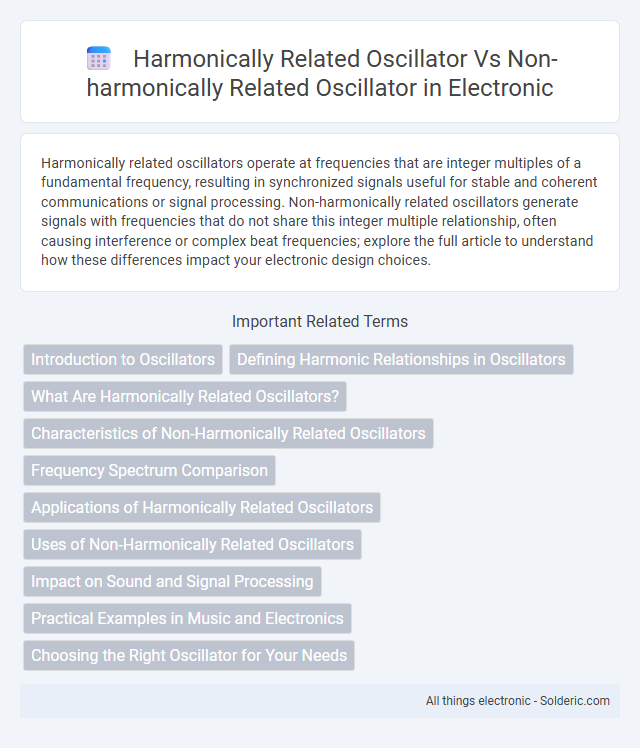Harmonically related oscillators operate at frequencies that are integer multiples of a fundamental frequency, resulting in synchronized signals useful for stable and coherent communications or signal processing. Non-harmonically related oscillators generate signals with frequencies that do not share this integer multiple relationship, often causing interference or complex beat frequencies; explore the full article to understand how these differences impact your electronic design choices.
Comparison Table
| Feature | Harmonically Related Oscillator | Non-Harmonically Related Oscillator |
|---|---|---|
| Frequency Relationship | Frequencies are integer multiples of a fundamental frequency | Frequencies have no integer multiple relationship |
| Signal Stability | High stability due to harmonic alignment | Lower stability, more susceptible to phase noise |
| Phase Noise | Lower phase noise; harmonics reinforce stability | Higher phase noise; independent frequency sources |
| Complexity | Moderate; simpler frequency synthesis | Higher; requires advanced mixing and control |
| Applications | Radio transmitters, PLLs, frequency synthesizers | Multi-band radios, spread spectrum systems |
| Interference & Crosstalk | Reduced interference; predictable harmonics | Increased risk due to unrelated frequencies |
| Phase Synchronization | Enabled by harmonic relationships | Usually no synchronization possible |
Introduction to Oscillators
Oscillators generate repetitive waveforms used in signal processing and communications, where harmonically related oscillators produce output frequencies that are integer multiples of a fundamental frequency, enabling stable phase relationships and simplified frequency synthesis. Non-harmonically related oscillators operate at frequencies unrelated by integer multiples, resulting in more complex signal combinations and broader spectral coverage for applications like spread spectrum and radar systems. Understanding the distinction aids in selecting the appropriate oscillator type for specific frequency stability, phase coherence, and spectral purity requirements.
Defining Harmonic Relationships in Oscillators
Harmonic relationships in oscillators occur when the frequencies are integer multiples of a fundamental frequency, creating a stable and predictable waveform essential for applications requiring frequency synchronization and signal coherence. Non-harmonically related oscillators operate at frequencies without integer ratios, resulting in more complex and less predictable signal interactions, often used for noise generation or complex modulation schemes. Understanding these distinctions helps you select the appropriate oscillator type for precise frequency control or for crafting intricate signal patterns in communication and signal processing systems.
What Are Harmonically Related Oscillators?
Harmonically related oscillators generate frequencies that are integer multiples of a fundamental frequency, ensuring phase coherence and stable signal synthesis in applications like communication systems and signal processing. Non-harmonically related oscillators produce frequencies without integer multiple relationships, leading to more complex spectra and potential phase instability. This distinction is critical for designing frequency synthesizers, mixers, and modulation schemes where spectral purity and signal integrity are paramount.
Characteristics of Non-Harmonically Related Oscillators
Non-harmonically related oscillators generate frequencies that do not share integer multiples, resulting in more complex and less predictable signal spectra. These oscillators often produce beat frequencies and intermodulation products, offering unique advantages in applications requiring frequency mixing or complex waveform synthesis. Your system's frequency stability and spectral purity can be affected by the inherent non-linear interactions of non-harmonically related oscillators.
Frequency Spectrum Comparison
Harmonically related oscillators produce frequencies that are integer multiples of a fundamental frequency, resulting in a frequency spectrum with distinct, regularly spaced spectral lines that create a clear harmonic structure. Non-harmonically related oscillators generate frequencies without integer multiples, leading to a more irregular and complex frequency spectrum that lacks a predictable harmonic pattern. Understanding these spectral differences helps you design audio and signal processing systems that require either harmonic coherence or spectral diversity.
Applications of Harmonically Related Oscillators
Harmonically related oscillators are widely used in communications and signal processing systems for generating stable frequency references and synthesizing complex waveforms through frequency multiplication or division. These oscillators enable precise phase locking in phase-locked loops (PLLs), facilitating coherent signal generation critical in radar and wireless communication technologies. Their ability to maintain integer multiple frequency relationships ensures efficient spectral management and reduced signal interference in multi-carrier transmission systems.
Uses of Non-Harmonically Related Oscillators
Non-harmonically related oscillators are essential in applications requiring multiple independent frequencies, such as spread spectrum communications and frequency hopping systems. They enable flexible, interference-resistant signal generation by producing signals that do not share harmonic relationships, reducing crosstalk and intermodulation distortion. These oscillators are also used in multi-carrier transmission systems and advanced radar technologies to achieve diverse frequency outputs for complex modulation schemes.
Impact on Sound and Signal Processing
Harmonically related oscillators produce frequencies that are integer multiples of a fundamental frequency, resulting in a more musically consonant and stable sound ideal for synthesizers and audio signal processing that require tonal coherence. Non-harmonically related oscillators generate frequencies that do not share a simple integer relationship, creating more complex, dissonant timbres useful for sound design, noise generation, and experimental audio effects. In signal processing, harmonically related oscillators facilitate easier spectral analysis and filtering, whereas non-harmonically related oscillators demand advanced algorithms for effective manipulation due to their less predictable frequency distribution.
Practical Examples in Music and Electronics
Harmonically related oscillators generate frequencies that are integer multiples of a fundamental frequency, commonly used in synthesizers to create rich, musical timbres such as additive synthesis and frequency modulation. Non-harmonically related oscillators produce frequencies that do not share a simple ratio, often utilized in electronic noise generation, sound design for effects, and in creating atonal or dissonant textures. In electronics, harmonically related oscillators facilitate stable signal generation for radio transmitters, while non-harmonic oscillators are applied in random signal sources and complex modulation schemes.
Choosing the Right Oscillator for Your Needs
Selecting the right oscillator depends on your application's frequency requirements and signal purity. Harmonically related oscillators generate output frequencies that are integer multiples of a fundamental frequency, ideal for applications needing synchronized signals and low phase noise. Non-harmonically related oscillators provide independent frequencies without integer relationship, offering flexibility for diverse frequency generation but may introduce complexity in signal correlation for Your system.
harmonically related oscillator vs non-harmonically related oscillator Infographic

 solderic.com
solderic.com